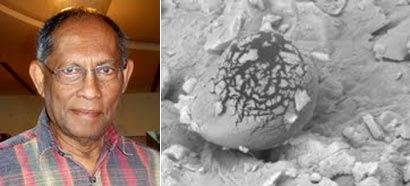A TEAM OF BRITISH SCIENTISTS LED BY CHANDRA WICKREMASINGHE CLAIM THEY DISCOVERED SIGNS OF LIFE IN A METEORITE FROM MARS

Onlanka News – by Walter Jayawardhana
A team of British scientists have announced that they discovered signs of life in a meteorite recovered last year from a desert in Morocco.
The team, in a preliminary study published in the current issue of the Journal of Cosmology, say the electronic microscope pictures taken by the team of interior sections of the piece of meteorite show “signs of life”.
“In July 2011 a rare meteorite from Mars fell over the deserts of Morocco and was recovered fairly shortly afterwards in October at a location near the village of Tissint. This so-called Tissint meteorite was blasted off the surface of Mars by a comet or asteroid impact several million years ago”, a press release issued by the Buckingham Center for Astrobiology said.
A piece of this rare meteorite has been examined by a team of scientists at the Buckingham Centre for Astrobiology and Cardiff University led by Jamie Wallis and Professor Chandra Wickramasinghe, Director of the Buckingham Centre for Astrobiology. The team has completed a preliminary study and reported the discovery of signs of life in the meteorite in the current issue of the Journal of Cosmology (Jamie Wallis et al, 2012).
http://journalofcosmology.com/JOC18/TissintFinal.pdf
Spherical globules rich in Carbon and Oxygen have been discovered in the interior of the meteorite embedded in the rocky matrix, No reasonable explanation is available for these structures unless they have been produced by life, they claimed. Jamie Wallis, a PhD student, who carried out the laboratory work on the meteorite said: “Other work to confirm our proposal is well under way and all the indications are that structures such as we have found are evidence of life on Mars. The spheres are probably remnants of polysaccharide shells surrounding algal type cells.”
Fig – A carbon-oxygen rich particle in the interior of the Tissint meteorite: An ovoid shaped carbon-oxygen rich globule cracking under gold coating in an SEM examination
Searches for life on Mars over the past 4 decades have had a speckled record. The results of the experiments carried out by NASA’s Viking Landers in 1976 under the leadership of Professor Gil Levin were regarded as indecisive or negative for a long time, but a recent reappraisal has led to the conclusion that the Viking results can only be interpreted as evidence for life. In 1996 the Mars meteorite ALH84001 turned up with images and spectra that were interpreted as signs of life, but later disputed as being inconclusive.
The new results on the Tissint meteorite could provide further compelling evidence for life on Mars – at any rate at the time the meteorite was blasted off from the planet millions of years ago, the team claimed.
In a telephone interview Professor Chandra Wickramasinghe the lead scientist in the team said, “A great deal of evidence has accumulated since the 1976 Viking Missions to Mars produced positive results for life. NASA has continued to play down all such evidence, and to prevaricate on whether or not there is life on Mars. This is possibly connected with funding – no life found may be thought to be a justification for more big money being spent on future Mars projects. It seems ironical that the tipping point for a long-resisted paradigm shift turns on a simple microscope inspection of this new Mars meteorite. Similar situations are of course well documented in the history of science. Evidence accumulates against a reigning paradigm without effect until a single new observation turns the tide.”
Latest Headlines in Sri Lanka
- Two U.S. Air Force aircraft arrive in Sri Lanka to support Cyclone Ditwah relief efforts December 7, 2025
- Myanmar sends humanitarian aid to Sri Lanka following severe weather December 7, 2025
- Sri Lanka President orders accurate data and fast disaster recovery in Matale December 7, 2025
- India sends Bailey Bridge parts to Sri Lanka to rebuild damaged bridges December 7, 2025
- Lanka Ashok Leyland donates vehicles worth Rs. 65 Million to support Sri Lanka’s disaster response December 6, 2025



As I believe that many planets contained its own biological forms or lives. We are as humans not able to track or seeing those species as they are in different form and different structures. Means they are invisible to our eyes as we can see only specific ratio.
Since this meteorite falls to the earth it might absorb the earth stuffs such as oxygen and other forms very easily. So will it be a 100% accurate to say it really has life forms in MARS? These are might thoughts ….
Those’re signs of “Mars” choco bars..!
Our current scientific perception to “life” is based on Oxygen and water. However, we cannot logically assume that these MUST be the only basis of all forms of “life” everywhere in the universe.
We are just a tiny tiny dot in the universe and we may have the most odd and different type of life compared to other types of life if exists in the universe. We probably are running behind a mirage.
So far we weren’t able to do proper investigations outside our own solar system which is only a “tiny particle” of the whole universe, where we don’t even know the ends and limits of it.
Lord Buddha has once said “do not to worry about the extent of the universe, it is not worth it, there are many more other important things to do in life”.